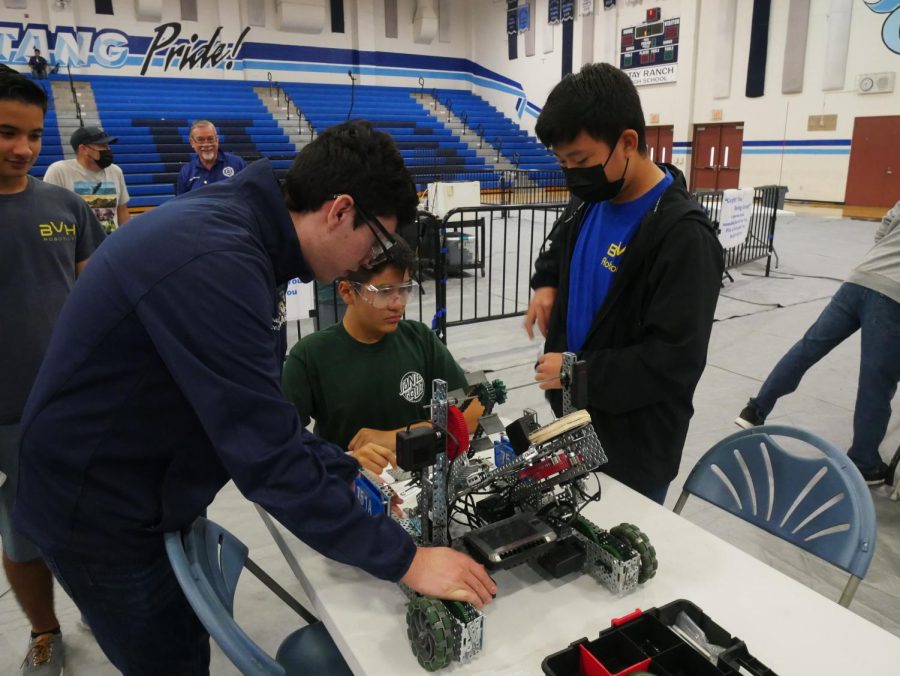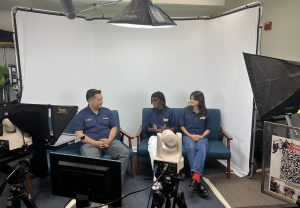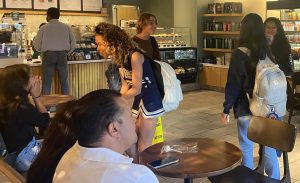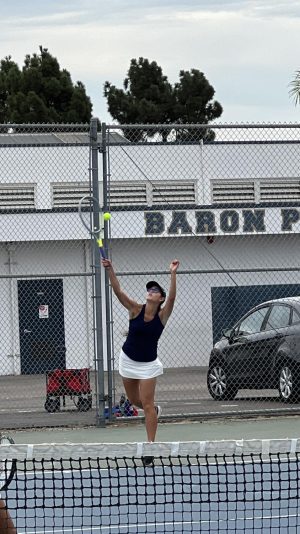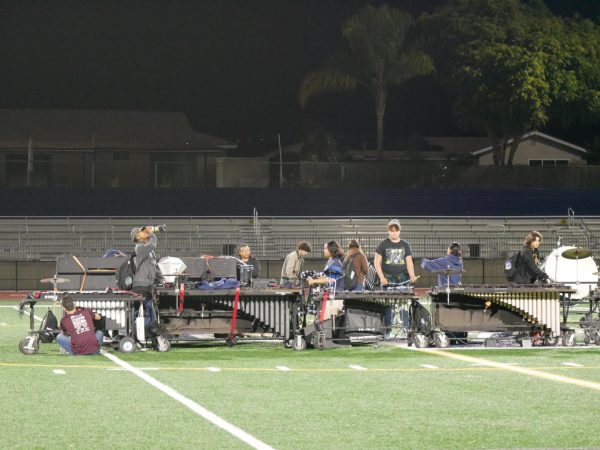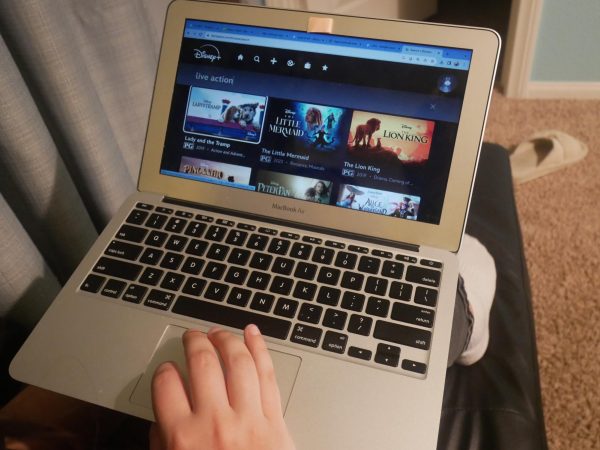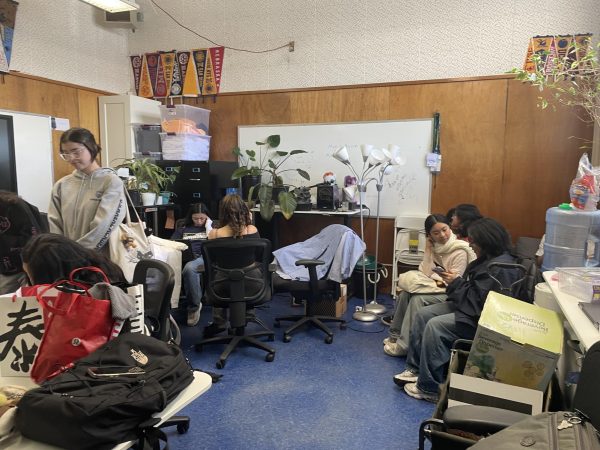Robotics club “spins up” the competition
BVH Robotics club has the first competition of the 2022-23 season
Minutes before a match Team “A” from Bonita Vista High repair their robot at Olympian High School in Chula Vista. On the far left, Sebastian Higuera oversees on his left Noah Caballero, Gabriel Jimenez worries for time deadlines shortening as Alvin Lim (right) works on the robot.
On September 10, Bonita Vista High (BVH) Robotics club participated in their first competition of the season at Otay Ranch High (ORH). The club consists of four teams, A, B, C and recently added D. The first four competitions are qualifiers, with the first competition being for ranking purposes.
The competition at ORH was the first of four qualifiers–BVH included– and will participate to solidify their rank in the district and against other schools. Teams A through D competed in seven matches throughout the day, paving the way for their first ranking of the season. IB English HL1 teacher and Robotics advisor Jason Good has been in charge of the Robotics Club for over four years. Good helped in clarifying the inner workings of the competition on Friday Sept. 9, the day before the match.
“They’re likely to have about seven official matches tomorrow and it just creates a ranking system. So if there are 50 teams in the league, then [we will] be ranked,” Good said.
At Saturday’s competition there were 21 schools participating, though not all schools were required to be there. Each school or team gets one ‘bye’ which is a free pass to skip participating in a competition and just watch. The qualifying matches help the team gain experience, understand how other teams work and give them a chance to brainstorm changes to their bots.
“You can earn a certain number of points [in the competition]. It develops a ranking system, and that ranking system applies to the leagues qualifications,” Good said.
Starting preparation as early as August, the season lasts for just over six months, and can go as long as eight or 10 months total. After the first four qualifying competitions, robotics has league championships, invitationals, and can go to the state tournament. If they move on from all levels, they are able to advance and go to world competitions.
“The season is effectively September to January. Then after that there are world competitions, but those are the playoffs. Those are extended seasons,” Good said.
Every season each team builds their robots to be able to participate in one game. Announced at last year’s VEX Worlds competition in April, this year’s game is called “Spin Up”, making a huge part of their functions based on flywheels, which are notoriously hard to use. Last year, BVH’s Robotics Club took their ‘bye’ for the first competition, leaving them with less competition experience and understanding of the game. Senior Vice President and Team A Captain, Noah Caballero was nervously excited for the first match.
“It’s like the first competition of the year is always a really nerve wracking one. It feels better knowing that everybody’s had the same amount of experience,” Caballero said. “Last year we went in, our first competition was the second of the year. So we were going against teams that had a lot of time to prepare to actually experience the game.”
At the same time last year, there were only three teams that made up the Robotics club. Though, due to the growth in membership, a fourth team was added to accommodate the larger amounts of students participating in the program. This benefited the growth of the club, however this meant less preparation and adjustment time for the new team. Senior Dorien Geske-Wilson was notified that he was to be the captain of the new team “D”.
“By the time I was alerted that there was gonna be a new team and I was gonna be the captain, we were already two weeks into our building schedule. Everybody had already designed their bots and had most of their structures and metal in place,” Geske-Wilson said.
In order for the bot to be as nice as possible, they use metal almost exclusively, with gears and other add-ons being exceptions. Due to the selective nature of their material needs, obtaining their supplies proves to be a challenge. Another barrier they face is that each team builds their own bot, needing several of the same pieces.
“So there’s [a website] called the VEX website and they basically have all the materials and electronics that you can order directly off their site. We have seven cortex motors, a battery and spare battery that’s over a grand,” Geske-Wilson said.
A big problem the club faces is budgeting. They have had to fundraise for most of their supplies, but they also have connections with other schools in the district which helps them to get most of their metal secondhand, saving them lots of money.
“[Metal supplies] was given to us by some other teams in the district. I know Mr. Good has had other teams support him and give him the materials,” Geske-Wilson said. “That’s part of what we have now. And then a lot of it comes down to our fundraising cause we don’t get funding from the district. A lot of it comes down to us fundraising for metal screws [and] the actual motor sometimes.”
This year the assigned game is one that focuses on spinning mechanics. Using objects like flywheels to shoot discs and conveyor belts to pick up the discs. The game itself consists of four possible point collecting components. The highest number of points earned at one time is 10 by changing the color of the rollers surrounding the edge of the fields. The next is at the end of the game however many tiles are covered by the bot and each square is three points. The other opportunities are the disc goals. The high goal, in which the disc needs to be shot in order to reach it, is worth five points and if it misses and lands in the marked off goal underneath, it is one point for the other team.
“There’s these yellow discs that are on the field and you have to try to pick those up with your bot and shoot them into this Frisbee golf-looking net,” Geske-Wilson said.
Even though this competition was the first of four qualifying, the teams were more focused on getting competition experience rather than ranking high. Though practicing two days a week for at least two hours can aid in progress, it cannot compare to the real competition.
“Today is more so practicing and getting a feel for everything. It’s always nice to win, but really it’s more so for the experience this time around,” Caballero said.
The competition starts with field one’s control mechanism failing, leaving only the second field until they are able to reset and fix it. Thankfully it didn’t impede too much, only setting the schedule back about 10 minutes. For team D, the first three matches of the day did not go their way, losing 32-36, then 35-50, and lastly 40-114.
“After those first three matches we just kept getting screwed over. We made mistakes and we just got paired up against bots that were so much better,” Geske-Wilson said.
Although the day started rough, team D made a comeback in their fourth match winning with a staggering score of 67-21. The team seemed to have a new pep in their step, as well as a new found confidence in their abilities.Using this newly invigorated confidence, team D goes on to win their last four matches. Winning their fifth match with a score of 63-53 and facing BVH’s very own team A and winning with a score of 61-50. Their last match of the day was won with an astonishing score of 79-31. Geske-Wilson shares pride in himself, his teammates and their improvisation skills.
“One of the matches our wheel fell off but we still won. [I’m] happy about that. It fell off at the beginning and we had to just somehow find a way to drive it during that match. Then after that match, we had maybe three minutes before we got thrown into another, which is a really short time and we were just really doing as much as we could just to make sure we had a bot on the floor,” Geske-Wilson said.
Although team D won the last four of their matches and ranked eighth out of the 21 schools there, they are looking forward to improving their bot. Due to the late addition of team D, they were deprived of very important planning and building time, leaving them with some unresolved issues.
“I think we could just work on overall [the] structural integrity of the bot. Our bot is pretty structurally sound. It definitely could be a lot more stable and there’s a flywheel that we’re working on the bots,” Geske-Wilson said.
As stated previously, each team is required to take one of the qualifying matches off. The club will be taking their bye for the next qualifier, in October, which gives them more time to make any changes and prepare more.
“We get a bye for this October one, which is very nice, cause we get to experience everybody else’s bots. See what works, see what doesn’t, see possible issues and gain more insight on what the ‘meta’ will be,” Geske-Wilson said.
Out of 21 schools, each with three to four teams, team D ranked eighth. Team C, captained by senior and Robotics club President Stephanie Ling ranked 11. Team A, captained by Caballero ranked 15. Lastly, Team B, captained by senior Valeria Valencia ranked 16. These rankings will change as they compete in the next three qualifiers.
“That’s the thing I like about robotics. It’s all improvisation and just coming up with solutions on the fly or finding a creative way to work around a problem,” Geske-Wilson said.
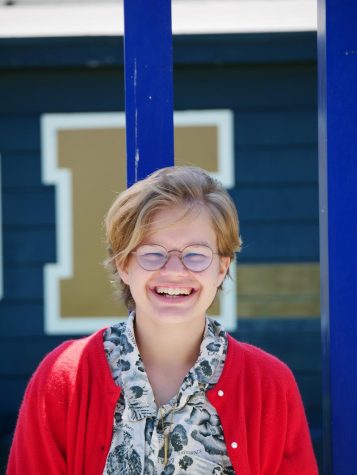
I am a senior at Bonita Vista High and this is my first year as a staff member for the Crusader. I am extremely excited to be News Editor this year and...
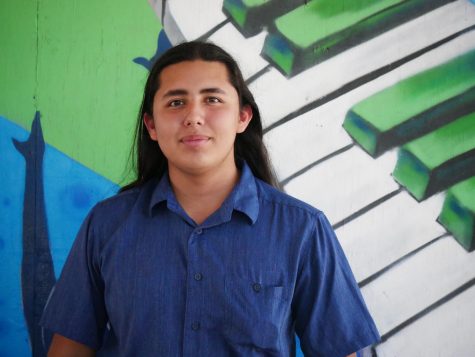
I am a junior at Bonita Vista High and this is my first year on staff for the Crusader. This year I am a photographer. I became a member of the Crusader...

